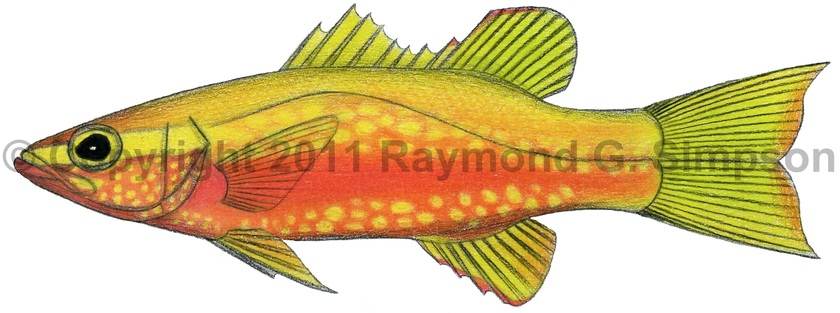
Common Name
Golden Basslet
Year Described
Poey, 1860
Identification
Dorsal Fin: VIII-IX, 12.5
Anal Fin: III, 8.5
Pectoral Fin: 14
Pelvic Fin: I, 5
Gill Rakers: 17-18 (first arch)
Lateral Line Scales: 46-48 (pored)
Vertebrae: 24 (10 precaudal, 14 caudal)
Body elongate, compressed, and robust. Body depth 27-29% SL. Head pointed. Forehead profile straight. Eye moderate to large. Mouth extends to rear half of orbit. Lower jaw projects. Rear corner of maxilla with a blunt ventral projection. Preopercle not serrated. Opercle with one stout middle spine and two accessory spines. Spiny and soft dorsal fin connected by fin membranes, but with a strong notch. Dorsal, anal and caudal fin with pointed tips to each lobe. Caudal peduncle strong. Tail slightly forked with extended lobes. Body and entire head with ctenoid, deciduous scales. Fin membranes scaled. Scales around caudal peduncle number 44.
Color
Body bright orange-red to red with a rose head. Scales on the dorsum are almost entirely filled with yellow pigment, making the dorsal half of the body yellow with reticulations of the basal color on scale edges. A broad yellow stripe runs from the snout to the opercle and blends into the dorsum pigmentation. The lower head has more widely separated yellow spots. The fins are bright yellow with rose edging. Juveniles are pale rose with diffuse yellow chromatophores and the yellow eye-stripe.
Size
Maximum size to 135mm SL.
Habitat
Mesophotic on deep reefs and walls (89-241m).
Range
Scattered records off the SE U.S., the Bahamas, Cuba, Curacao, and Brazil.
References
Baldwin, C. C., & Robertson, D. R. 2014. A new Liopropoma sea bass (Serranidae, Epinephelinae, Liopropomini) from deep reefs off Curaçao, southern Caribbean, with comments on depth distributions of western Atlantic liopropomins. ZooKeys, (409), 71.
Robins, C. R. 1967. The status of the serranid fish Liopropoma aberrans, with the description of a new, apparently related genus. Copeia 1967 (no. 3): 591-595.
Other Notes
The genus Chorististium had been erected in the past for these smaller Liopropoma with more separated dorsal fins (rubre, carmabi, mowbrayi, eukrines in our area). The genus Pikea was used for larger Liopropoma with notched but noticeably connected dorsal fins (aberrans, olneyi, santi in our area). Recent phylogenetic work shows Liopropoma is paraphyletic with the inclusion of Bathyanthias in the phylogeny, so they will eventually all be lumped into Liopropoma or several new genera will be proposed for the different clades.
Apparently the only specimen known of this species with 9 dorsal spines is Poey’s original description. Until more material from that area is found, it is possible Poey was describing a different species (olneyi?) or his count was in error or aberrant. Baldwin & Robertson (2014) note the differences in coloration between Liopropoma cf. aberrans from Cuba, the Bahamas, Curacao, and Jamaica and note that there may be at least two species in this complex. Apparently Curacao specimens are found at a shallower depth than the Bahamian specimen from Robins (1967), and have yellow spots on the cheeks.